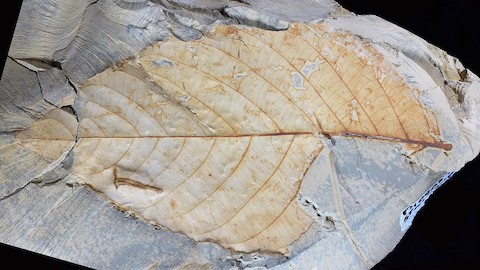
Credit: Daniela Carvalho/Smithsonian Tropical Research Institute
The Amazon rain forest. Scientists believe it holds thousands of species of plants, animals and insects we have yet to identify. And at least 50 tribes who have still not had contact with the outside world.
But before it could become the marvel it is today, the rain forest had to burn to the ground.
That big burn was caused by the same asteroid that wiped out the dinosaurs.
Scientists have studied Amazonian fossil plants from a few million years before and after the asteroid to reconstruct the story. It looks like this:
70 million years ago, the Amazon basin was lightly covered in conifers and ferns.
Large herbivorous dinosaurs ate huge volumes of plants and trampled others, keeping the forest in check.
Then the asteroid struck, sending a shockwave of fiery winds that flattened and incinerated the Amazon forest.
When the skies cleared, greenhouse gases from the blast and fires trapped more heat in the atmosphere.
In this new, warmer environment, the same conifers and ferns didn’t regrow. This left the Amazon basin open for new competitors: flowering plants.
Over a few million years, these evolved into thousands of species, from the towering broad-leaf trees that dominate the rain forest today to the many smaller plants that live in their shadows.
We know the Amazon as the most biodiverse place on Earth. But it never could have gotten there without the asteroid that cleared out the old to make way for the new.
Background
Synopsis: The Amazon is Earth’s largest rain forest, covering more than one-third of South America. Today’s diversity of life in the Amazon is greater than anywhere else in the world, but it was not always that way. In addition to blasting the Mesozoic into the Cenozoic and causing the extinction of nonavian dinosaurs 66 million years ago, the Chicxulub impact event also leveled the Amazon, changing its forest forever.
- Most of the Amazon River basin is in Brazil, but it also covers parts of Bolivia, Peru, Ecuador, Colombia, Venezuela, Guyana, Suriname and French Guiana.
- The Amazon basin covers more than 1.4 billion acres (5.67 million km2) and may influence weather patterns as far away as the United States.
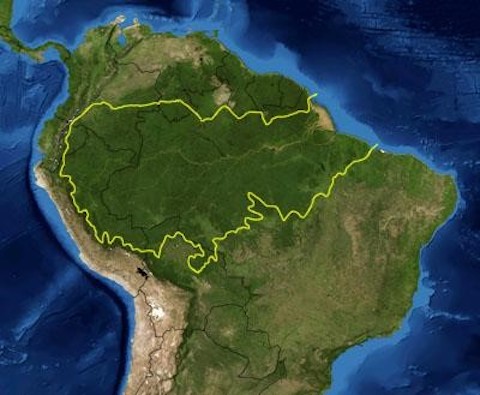
Credit: Pfly, via Wikimedia Commons
- With a length of around 4,000 mi (6,400 km), the Amazon River is the second-longest in the world, rivaling Africa’s Nile River.
- The Amazon River’s 1,100 tributaries carry about 20% of the water that flows over Earth’s surface.
- Its flow volume is about 12 times larger than that of the mighty Mississippi River.
- Amazon River outflow dilutes the salinity of the Atlantic more than 100 mi (160 km) from its river mouth.
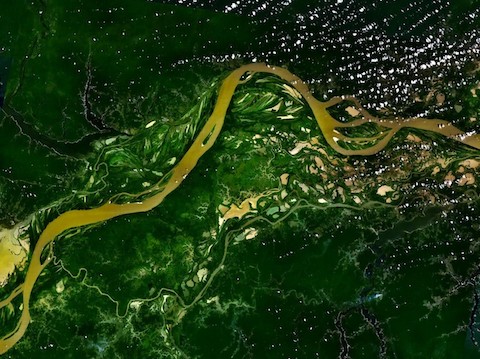
Credit: Rex, via Wikimedia Commons
- The Amazon rain forest hosts incredible diversity of life.
- More than 390 billion individual trees represent more than 16,000 tree species.
- More than 24,000 additional plant species grow among the trees.
- More than 2.5 million species of insects live in the Amazon, along with 3,000 fish species, 1,300 bird species and 430 mammal species.
- More than 400 Indigenous tribes inhabit the Amazon, and as many of 50 of these have never had contact with outsiders.
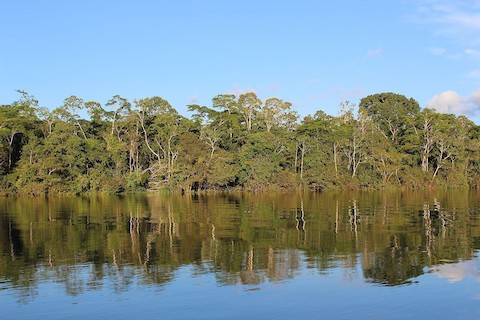
Credit: Antonio Campoy, via Wikimedia Commons
- The Amazon rain forest is often referred to as the lungs of Earth.
- Photosynthesis that occurs within the Amazon rain forest’s huge biomass consumes massive volumes of carbon dioxide, producing oxygen for Earth’s animals.
- The Amazon has been essential to life on Earth for many millions of years, but it has not always been the Amazon we know today—the Chicxulub impactor completely changed the rain forest 66 million years ago.
- Studies of fossil leaves and pollen spanning the time of the impact reveal that not only did the Mesozoic Amazon forest lose its dinosaurs, it also lost its trees.
- When the forest grew back in the Cenozoic, it was much different than before.
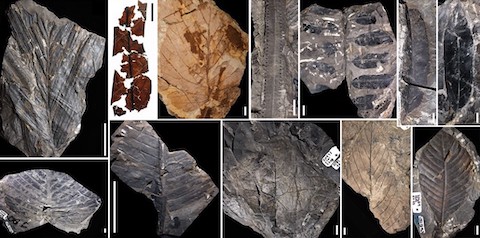
Credit: Carvalho and others, Science
- For more than 12 years, researchers examined and cataloged details of more than 6,000 fossilized leaves and 50,000 fossilized pollen samples ranging in age from 70 million years old (from the last part of the Mesozoic late Cretaceous Maastrichtian Age) to 56 million years old (from the first part of the Cenozoic Paleocene Epoch).
- Before the impact, the forests comprised a mix of conifers (gymnosperms) and ferns with an open canopy, enabling bright light to reach flowering plants on the forest floor.
- The Chicxulub impact brought huge earthquakes, tsunamis, fires and 600-mph (965 km/h) winds. Afterward, ash and debris blackened the sky for many months, limiting photosynthesis and cooling the planet. Then, as the skies cleared, the planet superheated.
- The disappearance of fossil pollen indicates many Amazon species became extinct at the time of the impact; plant diversity declined by 45%.
- After the impact, the forest’s ferns and cone-bearing plants disappeared, with flowering plants (angiosperms) dominating 90% of the plant species in the rain forest.
- These big-leaved, deciduous trees create the characteristic closed canopy of the Amazon rain forest.
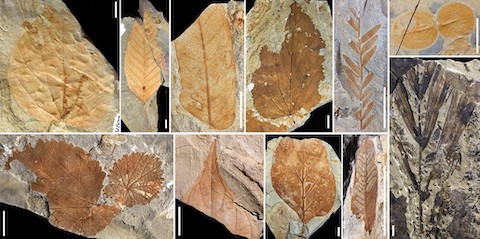
Credit: Carvalho and others, Science
- Scientists studying the dramatic change in the Amazon flora around 66 million years ago believe it is tied to both the physical effects of the impact as well as the transformation of the forest’s fauna.
- Large creatures perished in the aftermath of the impact, starving as their food sources disappeared.
- The largest creatures to survive were crocodiles, but most other survivors were small scavengers weighing less than 50 lbs (23 kg).
- Seeds replaced leaves as a vital food source at the base of the food web.
- Without tall dinosaurs opening up the forest canopy by feeding on it and trampling younger plants to the ground, flowering plants were able to diversify, with some evolving into the giant trees we see today with heights of nearly 300 ft (90 m).
- Soils of the humid late Cretaceous were leached of nutrients, favoring the growth of gymnosperms and causing angiosperms to struggle.
- The impactor brought cosmic nitrogen and phosphorus along, which rained down on the forest floor along with nutrient-rich ash sourced from massive global fires.
- Once the air cleared, this fertilizer improved the quality of Amazon soils, encouraging the expansion of fast-growing flowering plants that blocked sunlight from slower-growing conifers and ferns, taking over the rain forest.
- Large creatures perished in the aftermath of the impact, starving as their food sources disappeared.
- Although the canopy developed earlier, it took 6 million to 7 million years for the angiosperm forest to finally reach the level of biodiversity that had existed in the gymnosperm forest prior to impact.
- While we might appreciate the metamorphosis of the Amazon basin that created the most biodiverse ecosystem on Earth, the animals living at the time of its transformation surely did not.

